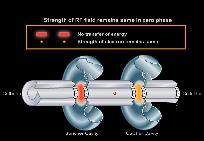Microwave Engineering
Microwaves are electromagnetic waves with wavelengths ranging from as long as one meter to as short as one millimeter, or equivalently, with frequencies between 300 MHz (0.3 GHz) and 300 GHz.[1] This broad definition includes both UHF and EHF (millimeter waves), and various sources use different boundaries.[2] In all cases, microwave includes the entire SHF band (3 to 30 GHz, or 10 to 1 cm) at minimum, with RF engineering often putting the lower boundary at 1 GHz (30 cm), and the upper around 100 GHz (3mm).
Unit 1: Transmission Line
General representation of E M field in terms of TEM, TE and TM components, Uniform guide
structures, rectangular wave guides, Circular Wave guides, Solution in terms of various
modes, Properties of propagating and evanescent modes, Dominant modes, Normalized
model voltages and currents, Power flow and energy storage in modes frequency range of
operation for single mode working, effect of higher order modes, Strip line and micro strip
lines-general properties, Comparison of coaxial, Micro strip and rectangular wave guides in
terms of band width, power handling capacity, economical consideration etc.
Unit 2: Networks and Component
Transmission line ports of microwave network, Scattering matrix, Properties of scattering
matrix of reciprocal, Nonreciprocal, loss less, Passive networks, Examples of two, three and
four port networks, wave guide components like attenuator, Phase shifters and couplers,
Flanges, Bends, Irises, Posts, Loads, Principle of operation and properties of E-plane,
H-plane Tee junctions of wave guides, Hybrid T, Multi-hole directional coupler, Direction
couplers, Microwave resonators- rectangular. Excitation of wave guide and resonators by
couplers. Principles of operation of nonreciprocal devices, properties of ferrites, Isolators
and phase shifters.
Unit 3: Solid State Devices
PIN diodes, Properties and applications, Microwave detector diodes, detection
characteristics, Varactor diodes, parametric amplifier fundamentals, Manley-Rowe power
www.s ku.bz a personalised online tutoring portal that redefines the learning experience in Maths, Science and Computers.
relation MASER, LASER , Amplifiers, Frequency converters and harmonic generators using
Varactor diodes, Transferred electron devices, Gunn effect, Various modes of operation of
Gunn oscillator, IMPATT, TRAPATT, BARITT.
Unit 4: Microwave Tubes
Interaction electron beam with electromagnetic field, power transfer condition. Principles of
working of two cavity and Reflex Klystrons, arrival time curve and oscillation conditions in
reflex klystrons, mode-frequency characteristics. Effect of repeller voltage variation on
power and frequency of output. Principle of working of magnetrons. Electron dynamics in
planar and cylindrical magnetrons, Cutoff magnetic field, Resonant cavities in magnetron,
?-mode operation Mode separation techniques, Rising sun cavity and strapping. Principle of
working of TWT amplifier. Slow wave structures, Approximate gain relationship in forward
wave TWT.
Unit 5: Microwave Measurements
Square law detection, Broadband and tuned detectors. Wave-guide probes, Probe and
detector mounts, Slotted line arrangement and VSWR meter, Measurement of wave-guide
impedance at load port by slotted line, Microwave bench components and source
modulation. Measurement scattering matrix parameters microwave power measurement-
High, Medium and low-level power measurement techniques. Characteristics of bolometers,
bolometer mounts, Power measurement bridges, Microwave frequency measurement
techniques calibrated resonators (transmission and absorption Type).
Complete Course Rs 1000

 Add to Cart
Add to Cart 